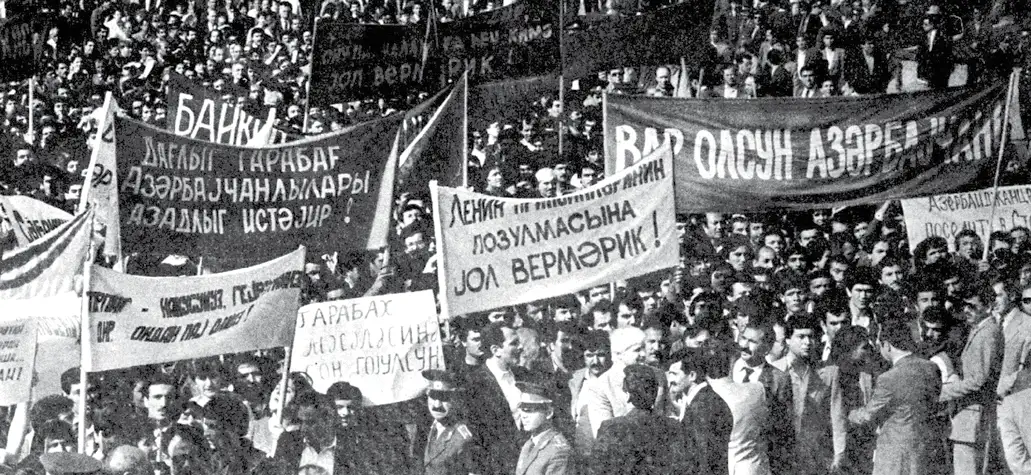
Dr. Michael Reinhard Heß
Michael Reinhard Heß ist promovierter und habilitierter Turkologe. Thema der Habilitation waren Leben und Sprache des aserbaidschanischen Dichters İmadәddin Nәsimi (1370–1417).
Zum Thema Karabach hat er die Bücher „Panzer im Paradies“ (Dr. Köster 2016) und „Karabakh from the 13th century to 1920“ (Gulandot, 2020) verfasst.
The year 1988 usually appears as the starting point of the late Soviet Karabakh conflict, which later turned into the First Karabakh War. This mark of historical periodization is used not only by Armenian and pro-Armenian historians (for instance, Soljan 1995: 152f.; Constant 2003: 327), but also by a number of Azerbaijani and neutral authors (for instance, Bayramov 2020; The Commissioner for Human Rights (Ombudsman) of the Republic of Azerbaijan 2020).
Ahead of discussing the adequacy of certain dates for the purposes of historical periodization (which can be described as the subdivision of the historical past into a sequence of periods or eras), one has to keep in mind that periodization dates are basically means for the structuring of historical discourses (in the form of books, articles, speeches, etc.). In such discourses, they can be absolute marks separating one historical period from another, one chapter form another, etc.
Few approaches to history can do without periodizations. There are certain years or dates that have become generally accepted as the end and beginning of historical periods because they seem to correspond to actual changes in the historical reality quite clearly. These dates include 1453 (all dates here are A.D.) for the end of the Eastern Roman period, 1945 (the end of World War II.) or 1991 (the beginning of the post-Soviet era). However, in many cases the choice of one particular year or date as the basis of a periodization chapter is not so evident and unequivocal. For instance, one may debate whether the era of reforms of the Ottoman Empire already began with sultan Selīm III. (ruled 1789-1808), who introduced a number of far-reaching reforms according to Western models (including the Niẓām-i Ǧedīd or “New Order” army), or with the onset of the Tanẓīmāt era (1839). As a matter of fact, periodization dates may show a certain flexibility depending on the perspective and intention of those who use them. In many cases, the preference of one date over another may not have a serious impact on the message conveyed by a historiographic text. For instance, whether one starts the period of Ottoman decay with the 1683 defeat at the gates of Vienna or with any other date or even may eventually prove to be a matter of taste. However, in other cases, even a seemingly slight difference in the choice of the date that marks the beginning of a period may completely change the meaning of a historiographic text.
This seems to be case if one looks at the difference between “1988” and “1987” (or an even earlier year) as the starting point of the late Soviet Armenian-Azerbaijani conflict. Whether the first or the second year is chosen as the starting-point of this conflict is of utmost importance and has the potential to upturn the outcome of the historical observation completely.
In looking at the theory that the NKAO Armenians´ quest for self-determination began in 1988 it must be kept in mind that leading Armenian intellectuals from Soviet Armenia had already sent a memorandum to the Soviet head of state Mikhail Gorbachev on March 5, 1987. In this text they openly demanded the annexation of both the NKAO and the Azerbaijani exclave of Nakhichevan to the Armenian Soviet Socialist Republic (see Asenbauer1993: 80). In August 1987, a petition with the same stated aim – i.e., to annex both the NKAO and Nakhichevan to the Armenian Soviet Socialist Republic –was organized simultaneously both in Armenia and in the NKAO (Asenbauer1993: 79f.). Incidentally, these two initiatives are only two of the many measures taken by Armenians in Soviet Armenia, Azerbaijan, and in the diaspora in connection with the project to annex the NKAO to Armenia already in 1987. All of these activities directly contributed to and prepared the separatist activities taken in 1988, including the February 20, 1988 text published by the Armenians delegates of the NKAO´s oblastnyj Sovet. Obviously, the Armenian separatist actions in Karabakh in 1988 cannot be separated from their preparations in 1987. They are part of a single and coordinated historical process. This process began at the latest in March 1987, but not only in 1988.
Incidentally, the above-mentioned March 5, 1987 memorandum is highly interesting for the theoretical understanding of the Armenian-Azerbaijani conflict also for a number of other reasons beside its placement in chronology. For instance, one should note that it directly joins the demand for the annexation of the NKAO with that of Nakhichevan. This constitutes an Armenian self-refutation of the hypothesis that the quest for “self-determination” on the part of the NKAO´s Armenians was one of the main motives of the whole separatist campaign at the end of the Soviet era. The reason is obvious: If “self-determination” of the NKAO Armenians was assumed to be a motive, its aim should have been to achieve a change of the NKAO´s status only but not also that of Nakhichevan.
Another interesting point concerns the authorship of the March 5, 1987 memorandum. According to Armenian historiography (Asenbauer 1993: 80, 315), the memorandum (and possibly also the text of the August 1987 petition) was composed by professor Սուրեն Այվազըան Suren Ayvazyan (this is the Armenian form of the name, the Russian being Suren Michajlovič Ajvazjan; he lived from August 4, 1933 to September 11, 2009).
Ayvazyan was an Armenian intellectual who, among other things, held a professorship of geology before becoming actively engaged in the separatist movement around the NKAO and Nakhichevan. In addition to his professional interest in geology, he also wrote articles and books on Armenian history and linguistic. However, he was neither a linguist or philologist nor an historian by training. As a consequence, some of the theories he developed about Armenian history and the Armenian language are outright nonsense. This includes the absurd idea that the name of the Biblical figure of Eve could be derived from the Modern Armenian word for “and” , եւ yev (cf. Heß 2016: 67f.). Also, Ayvazyan is said to have written a letter to Queen Elizabeth II of England in which he fantasized that the Anglo-Saxons had in fact been migrants who left “Armenia” (in Russian: Armenija) between the 15th and 10th centuries B. C. (!) to settle on the British Islands. The article in which Ayvazyan is quoted with this absurdity says that he pointed to the existence of a “province Angl-tun” (in Russian: oblast´ Angl-tun) in the Cilician kingdom, i.e., between the 11th and 14th centuries A. D. (!) to support this pseudo-theory. As can be seen, Ayvazyan does not see any problem in directly connecting historical events that happened at an interval of roughly two millennia. Ayvazyan believed in his own “Angl-tun” concoctions so firmly that on their basis he demanded that England should pay “one billion in an unknown currency” (in Russian: milliard v neizvestnoj valjute) in compensation to present-day Armenia (see the text of the article in (Maksimenko/ Sarkisjan 2021 [2001]).
The role Ayvazyan was able to play in the 1987 run-up of the conflict – which would ultimately turn into a bloody war with more than 30,000 dead and hundreds of thousands expelled – is in many respects revelatory about the causes of the conflict´s escalation. On one hand, his example shows how intellectuals became part of the political movement. On the other hand, it illustrates the fatal consequences the organization of the scholarly landscape in the late Soviet Union had on the degradation of the situation into a violent conflict. Had there been a free press and mechanisms of scientific quality control, pseudo-historians and linguists such as Ayvazyan would probably not have been taken seriously by anyone outside the usual circles of conspiracy theorists that exist everywhere and at all times, nor would such questionable authors have been able to influence a mass movement that involved the participation of millions. However, such mechanisms obviously failed to come into action.
Had she and the remaining majority of nationalist Armenian intellectuals of her generation listened to Gorbachev´s warning and remained silent or curbed their nationalist instincts, the horrible catastrophe that they helped to bring down on the Armenian and Azerbaijani people might have been avoided. Tens of thousands of young soldiers and civilians would still be alive, unfathomable suffering would have been avoided.
Asenbauer 1993. Asenbauer, Haig E.: Zum Selbstbestimmungsrecht des armenischen Volkes von Berg-Karabach. Vienna: Wilhelm Braumüller Universitäts-Verlagsbuchhandlung Ges. m. b. H.
Bayramov 2020. Bayramov, Jeyhun: Nagorno-karabakh is part of Azerbaijan. On that basis the war with Armenia can be ended. Https://www.washingtontimes.com/news/2020/oct/22/nagorno-karabakh-is-part-of-azerbaijan-on-that-bas/?fbclid=IwAR1ydugNmBIZ3AynQulo-rWXPko066TUsK9JCOz3kAxqVPfTRD97pq5fMWY [Article from the online edition of the Washington Times, dated October 22, 2020].
Constant 2003. Constant, Antoine: L´azerbaїdjan. Paris: Karthala.
Gorbačev 1995. Gorbačev, Michail: Žizn´ i reformy. Vol. 1. Moscow: Novosti.
Heß 2016. Heß, Michael Reinhard: Panzer im Paradies. Der Berg-Karabach-Konflikt zwischen Armenien und Aserbaidschan. Berlin: Dr. Köster.
Maksimenko/ Sarkisjan 2021 [2001]. Maksimenko, Oleg/ Sarkisjan, Anait: Angličane – ėto armjane i Britanija dolžna Armenii mnogo deneg. [Article marked as being from the Russian newspaper russ.Kommersant, 81 (May 15, 2001): 9] Https://www.kommersant.ru/doc/264720 [downloaded on December 27, 2021].
Soljan 1995. Soljan, Suren: Entstehungsgeschichte und aktuelle Probleme des Karabach-Konflikts. Krüger, Sandra (transl.). In: Halbach, Uwe/ Kappeler, Andreas (eds.): Krisenherd Kaukasus. Baden-Baden: Nomos. 129-160.
Teilen mit / Поделитесь
- Нажмите, чтобы открыть на Facebook (Открывается в новом окне)
- Нажмите, чтобы поделиться в Telegram (Открывается в новом окне)
- Нажмите, чтобы поделиться в WhatsApp (Открывается в новом окне)
- Нажмите, чтобы поделиться на Twitter (Открывается в новом окне)
- Нажмите, чтобы поделиться на Reddit (Открывается в новом окне)
- Нажмите, чтобы поделиться записями на Pocket (Открывается в новом окне)
- Послать ссылку другу по электронной почте (Открывается в новом окне)
- Нажмите для печати (Открывается в новом окне)
- Ещё
Больше на Masim💛v
Подпишитесь, чтобы получать последние записи по электронной почте.
